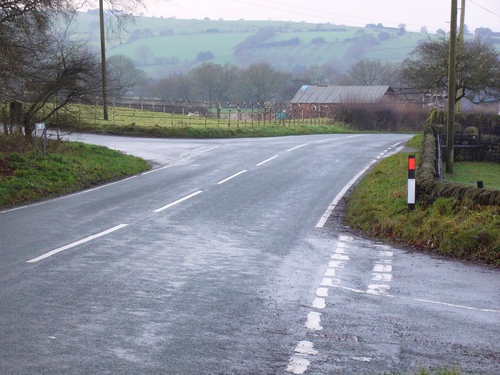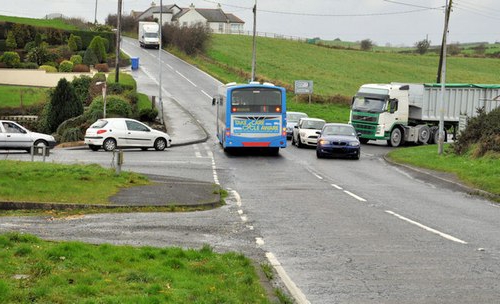At a regulated intersection, travel is carried out according to a fairly clear and understandable algorithm. So, if the driver sees an enable signal, then he can move, if forbidding, then no. All this is written in the SDA. An unregulated intersection has its own characteristics. Let us further consider how movement along it is carried out. 
Signs and classification
An unregulated intersection has the following distinguishing features:
- There is no traffic light.
- There is no traffic controller.
- The traffic light does not work or the yellow light flashes.
An unregulated intersection can be ambiguous or ambiguous. In the latter case, one path will be the main one, the other, or the other (if there are several) secondary.
Unregulated intersection rules
There are only three of them. They determine the priority of movement and are performed in the prescribed sequence. The rules for driving unregulated intersections are as follows:
- The advantage of the one who makes the movement on the main.
- Priority on the tram (if there are tracks).
- The rule of "interference on the right."

Movement on the "main"
How to determine which road the car is traveling? In this case, refer to the definition. The main road, in accordance with clause 1.2 of the SDA, is indicated by signs 5.1, 2.3.2-2.3.7, 2.1 with respect to the adjacent road or has a hard surface (stone material, cement and asphalt concrete, etc.). It is also any way regarding exits from adjacent territories. In some cases, in the section of the secondary road, which is located in front of the intersection, there is a hard surface. However, this does not make her equal to the one she crosses.
Tram advantage
This rule works if the rails are located on the main or equivalent to another road. If the tram moves along a secondary path, then it must give way to trackless vehicles located on the main one. If there are no tracks at an unregulated intersection, this rule is not taken into account.
"Interference on the right"
This rule applies if two vehicles are located on equivalent roads - both on secondary roads or both on main roads, and their routes intersect. The one with the right noise must give way. That is, the priority is one who moves on the right side. 
The main difficulties
The priority passage of unregulated intersections can thus be determined by the presence of the signs listed above, establishing where the “main” sign is, as well as by signs 2.4, which requires giving way, and 2.5, which prohibits passage without stopping. The latter indicate a secondary site.
However, today there are often intersections at which these signs are absent for some reason or hidden (for example, foliage of trees). The driver, however, in any case, you need to know which way he is moving - secondary or main. In this regard, approaching an unregulated intersection, when a motorist searches for a traffic light through his eyes, one should also look with his eyes for identification marks. The latter can be detected much faster, especially in sunny weather, because in bright sun the warning signals are not always given in time to recognize. 
Important point
Priority signs do not operate at the regulated intersection. However, while the driver has not decided which particular area he is approaching, with the help of identification marks, it should become clear which way the movement takes place - main or secondary.If it turns out that a traffic light is operating at the intersection or a traffic controller is present, then you can safely continue to drive without considering the priority signs. However, it may be that the traffic light does not work or shuts down suddenly. In this case, there will be an unregulated intersection, and the movement algorithm will be different.
The secondary and main path: additional information
If during the movement it was not possible to detect any signs, you should slow down. It is advisable to look at the other sides of the road. In some cases, the signs are duplicated on the left, sometimes they are suspended at the top, so it is not always possible to notice them immediately. If they weren’t anywhere, then it is worth looking at them in other directions. The signs on the reverse side can be identified by their shape. So, “Home” is a rhombus, a ban on non-stop traffic is an octahedron, “Give way” is an inverted triangle. If warnings are nevertheless found on either side, further movement is carried out in accordance with them. 
What to do if there are no signs?
In this case, it is necessary to significantly reduce the speed and drive up close to the intersection. Next, you should look again at all sides and corners. If any sign is found, the decision on further actions must be taken quickly. If there are absolutely no warnings, then this is an equivalent intersection. It does not act "interference on the right."
Unregulated intersection of uneven roads
As mentioned above, approaching the site, it is necessary to determine exactly which way the movement takes place - secondary or main. We will analyze the situation when all the signs are in place. At the same time, traffic is carried out along the main one, which goes straight without changes in direction, and there are no tram tracks. Recall the rules of unregulated intersections:
- The movement is carried out on the main. So, those vehicles that go on a secondary should pass. In this case, the direction of movement in the main value is not.
- There is no tram line, so the priority of this transport is not valid.
- The “interference on the right” rule is necessary if unregulated intersections travel with a left turn or a turn. However, before this you should skip cars moving along the "main" towards right and right.
Explanation
It’s not clear to everyone why “interference on the right” works if oncoming cars cross an unregulated intersection right with a right turn. This can be explained as follows. Mentally, you can turn the car to the left. In this case, oncoming cars will be on the right. As a rule, they should be skipped. If the oncoming vehicles turn right, then the situation will be the same - they will also be on the starboard side. And in this case they need to be skipped. 
Left turn
Before you perform it at an unregulated intersection, you should not only slow down, but also make sure that no one is behind to overtake. Define this in advance. When making a turn, you should quickly look at the left dead zone. If the vehicle in back has already gone to overtake, do not hinder it. In this case, it is advisable to reduce the speed and give him the opportunity to drive. After that, you can safely prepare for the turn.
Finally
Thus, driving up the main intersection to an unregulated intersection, the driver has full priority over vehicles moving along a secondary path. However, even in such cases it is recommended to slow down and switch to the lowest gear. So it will be possible to drive an unregulated intersection with a power reserve (in MKM mode). This will, if necessary, either accelerate sharply or slow down.
